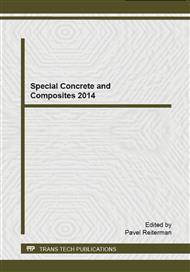[1]
Bernhardt M., Tellesbø H., Justnes H., Wiik K. Mechanical properties of lightweight aggregates. Journal of the European Ceramic Society 2013: 33, pp.2731-2743.
DOI: 10.1016/j.jeurceramsoc.2013.05.013
Google Scholar
[2]
Cui H. Z., Lo T. Y., Memon S. A., Xu W. Effect of lightweight aggregates on the mechanical properties and brittleness of lightweight aggregate concrete. Construction and Building Materials 2012: 35, pp.149-158.
DOI: 10.1016/j.conbuildmat.2012.02.053
Google Scholar
[3]
Mehta P. K. Concrete: structure, properties, and materials. 2nd ed. Englewood cliffs, NJ: Prentice-Hall Inc.; (1986).
Google Scholar
[4]
Short A., Kimniburgh W. Lightweight concrete. 3rd ed. London: Applied Science Publishers; (1978).
Google Scholar
[5]
Lo T. Y., Tang W. C., Cui H. Z. The effects of aggregate properties on lightweight concrete. Building and Environment 2007: 42, pp.3025-3029.
DOI: 10.1016/j.buildenv.2005.06.031
Google Scholar
[6]
Choi Y. W., Kim Y.J., Shin H. C., Moon H. Y. An experimental research on the fluidity and mechanical properties of high-strength lightweight self-compacting concrete. Cement and concrete Research 2006: 36, pp.1595-1602.
DOI: 10.1016/j.cemconres.2004.11.003
Google Scholar
[7]
The Swedish Ministry of Health and Social Affairs: Plan och hygglagen 2010: 900, The Swedish Planning and Building Act, Chapter 8 4§3. SFS 2010: 900.
Google Scholar
[8]
Čáchová M., Koňáková D., Vejmelková E., Keppert M., Polozhiy K. and Černý R., 2014, Pore structure and thermal characteristics of clay bricks, Advanced Materials Research, Vol. 982, pp.104-107.
DOI: 10.4028/www.scientific.net/amr.982.104
Google Scholar
[9]
Jain P. L. Principles of Foundry Technology (4th, revised ed. ), Tata McGraw-Hill 2003, ISBN 978-0-07-044760-8.
Google Scholar
[10]
Information on http: /en. wikipedia. org/wiki/Grog_(clay).
Google Scholar
[11]
Information on http: /www. secar. net/-Brochures.
Google Scholar
[12]
Scheinherrová L., Trník A., Vejmelková E., Reiterman P., Medveď I., Černý R., 2014, A Comparative study on thermal properties of two types of concrete containing fine ceramic waste and burnt clay shale as a supplementary material, Advanced Materials Research, Vol. 982, pp.79-83.
DOI: 10.4028/www.scientific.net/amr.982.79
Google Scholar
[13]
Information on http: /www. liaver. cz/liaver. php.
Google Scholar
[14]
Koňáková D., Vejmelková E., Špedlová V., Polozhiy K. and Černý R., 2014, Cement composites for high temperature applications, Advanced Materials Research, Vol. 982, pp.154-158.
DOI: 10.4028/www.scientific.net/amr.982.154
Google Scholar
[15]
Holčapek, O., Reiterman, P., Jogl, M., Konvalinka, P., 2014, Destructive and non-destructive testing of high temperature influence on refractory fiber composite, Advanced Materials Research, Vol. 982, pp.145-148.
DOI: 10.4028/www.scientific.net/amr.982.145
Google Scholar


